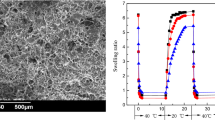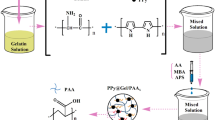Abstract
In this study, a novel temperature/pH dual responsive hydrogel, based on Hericium erinaceus residue carboxymethyl chitin (HCMC) and poly (N-isopropylacrylamide) (PNIPAm), was synthesized by sequential IPN technique. Series of IPN hydrogels were obtained by varying initial N-isopropylacrylamide (NIPAm) concentrations. The structure, morphology, thermal property, transparency, mechanical property, swelling kinetics, temperature/pH responses and 5-Fu release behavior of the prepared hydrogels were systematically investigated. The structure analysis results showed that the IPN hydrogels were successfully synthesized. The prepared hydrogels showed more compact network structure and enhanced mechanical property as NIPAm concentration increased, but reduced transparency, swelling degree and 5-Fu release ratio. More importantly, HCMC and PNIPAm ensured the pH and temperature responses, respectively. 5-Fu could be gradually released from the prepared hydrogels, which followed Fickian diffusion model. Therefore, the prepared hydrogels may be served as promising materials for drug delivery systems.









Similar content being viewed by others
References
Azarova YA, Pestov AV, Bratskaya SY (2016) Application of chitosan and its derivatives for solid-phase extraction of metal and metalloid ions: a mini-review. Cellulose 23:2273–2289
Bilbao-Sainz C, Chiou BS, Williams T, Wood D, Du WX, Sedej I et al (2017) Vitamin D-fortified chitosan films from mushroom waste. Carbohydr Polym 167:97–104
Chen JP, Cheng TH (2006) Thermo-responsive chitosan-graft-poly (N-isopropylacrylamide) injectable hydrogel for cultivation of chondrocytes and meniscus cells. Macromol Biosci 6:1026–1039
Chien RC, Yen MT, Mau JL (2016) Antimicrobial and antitumor activities of chitosan from shiitake stipes, compared to commercial chitosan from crab shells. Carbohydr Polym 138:259–264
Clarke DE, Pashuck ET, Bertazzo S, Weaver JVM, Stevens MM (2017) Selfhealing, self-assembled beta-sheet peptide-poly(gamma-glutamic acid) hybrid hydrogels. J Am Chem Soc 139:7250–7255
Croisier F, Jérôme C (2013) Chitosan-based biomaterials for tissue engineering. Eur Polym J 49:780–792
Dai H, Ou S, Liu Z, Huang H (2017) Pineapple peel carboxymethyl cellulose/polyvinyl alcohol/mesoporous silica SBA-15 hydrogel composites for papain immobilization. Carbohydr Polym 169:504–514
Dai H, Ou S, Huang Y, Liu Z, Huang H (2018a) Enhanced swelling and multiple-responsive properties of gelatin/sodium alginate hydrogels by the addition of carboxymethyl cellulose isolated from pineapple peel. Cellulose 25:593–606
Dai H, Huang Y, Huang H (2018b) Eco-friendly polyvinyl alcohol/carboxymethyl cellulose hydrogels reinforced with graphene oxide and bentonite for enhanced adsorption of methylene blue. Carbohydr Polym 185:1–11
Dai H, Zhang Y, Ma L, Zhang H, Huang H (2019a) Synthesis and response of pineapple peel carboxymethyl cellulose-g-poly (acrylic acid-co-acrylamide)/graphene oxide hydrogels. Carbohydr Polym 215:366–376
Dai H, Zhang H, Ma L, Zhou HY, Yu Y, Guo T, Zhang Y, Huang H (2019b) Green pH/magnetic sensitive hydrogels based on pineapple peel cellulose and polyvinyl alcohol: synthesis, characterization and naringin prolonged release. Carbohydr Polym 209:51–61
Dragan ES, Lazar MM, Dinu MV (2012) Preparation and characterization of IPN composite hydrogels based on polyacrylamide and chitosan and their interaction with ionic dyes. Carbohydr Polym 88:270–281
Gao XY, Cao Y, Song XF, Zhang Z, Xiao CS, He CL, Chen XS (2013) pH and thermo-responsive poly(N-isopropylacrylamide-co-acrylic acid derivative) copolymers and hydrogels with LCST dependent on pH and alkyl side groups. J Mater Chem B 1:5578–5587
Gharekhani H, Olad A, Mirmohseni A, Bybordi A (2017) Superabsorbent hydrogel made of NaAlg-g-poly(AA-co-AAm) and rice husk ash: synthesis, characterization, and swelling kinetic studies. Carbohydr Polym 168:1–13
Guo Y, Duan B, Cui L, Zhu P (2015) Construction of chitin/graphene oxide hybrid hydrogels. Cellulose 22:2035–2043
Haq MA, Su Y, Wang D (2017) Mechanical properties of PNIPAM based hydrogels: a review. Mater Sci Eng C 70:842–855
Higuchi T (1963) Mechanism of sustained action medication: theoretical analysis of rate of release of solid drugs dispersed in solid matrices. J Pharm Sci 52:1145–1149
Hirokawa Y, Tanaka T (1984) Volume phase transition in a nonionic gel. J Chem Phys 81:6379–6380
Hong S, Yang QR, Yuan Y, Chen L, Song YD, Lian HL (2019) Sustainable co-solvent induced one step extraction of low molecular weight chitin with high purity from raw lobster shell. Carbohydr Polym 205:236–243
Jaiswal MK, Banerjee R, Pradhan P, Bahadur D (2010) Thermal behavior of magnetically modalized poly(n-isopropylacrylamide)-chitosan based nanohydrogel. Colloids Surf B 81:185–194
Jalababu R, Veni SS, Reddy KVNS (2018) Synthesis and characterization of dual responsive sodium alginate-g-acryloyl phenylalanine-poly n-isopropyl acrylamide smart hydrogels for the controlled release of anticancer drug. J Drug Deliv Sci Technol 44:190–204
Karimi M, Ghasemi A, Zangabad PS, Rahighi R, Moosavi Basri SM, Mirshekari H et al (2016) Smart micro/nano particles in stimulus-responsive drug/gene delivery systems. Chem Soc Rev 45:1457–1501
Kim SW, Bae YH, Okano T (1992) Hydrogels: swelling, drug loading, and release. Pharm Res 9:283–290
Korsmeyer RW, Gurny R, Doelker E, Buri P, Peppas NA (1983) Mechanisms of solute release from porous hydrophilic polymers. Int J Pharm 15:25–35
Liao J, Huang H (2019a) Green magnetic hydrogels synthesis, characterization and flavourzyme immobilization based on chitin from Hericium erinaceus residue and polyvinyl alcohol. Int J Biol Macromol 138:462–472
Liao J, Huang HH (2019b) Magnetic chitin hydrogels prepared from Hericium erinaceus residues with tunable characteristics: a novel biosorbent for Cu2+ removal. Carbohydr Polym 220:191–201
Lima BV, Vidal RR, Marques ND, Maia AM, Balaban RD (2012) Temperature-induced thickening of sodium carboxymethylcellulose and poly(n-isopropylacrylamide) physical blends in aqueous solution. Polym Bull 69:1093–1101
Lin X, Ju X, Xie R, Jiang M, Wei J, Chu L (2013) Halloysite nanotube composited thermoresponsive hydrogel system for controlled-release. Chin J Chem Eng 21:991–998
Liu Z, Huang H (2016) Preparation and characterization of cellulose composite hydrogels from tea residue and carbohydrate additives. Carbohydr Polym 147:226–233
Liu J, Liu G, Liu W (2014) Preparation of water-soluble β-cyclodextrin/poly(acrylic acid)/graphene oxide nanocomposites as new adsorbents to remove cationic dyes from aqueous solutions. Chem Eng J 257:299–308
Liu H, Yang Q, Zhang L, Zhuo R, Jiang X (2016) Synthesis of carboxymethyl chitin in aqueous solution and its thermo- and ph-sensitive behaviors. Carbohydr Polym 137:600–607
Liu CM, Guo XJ, Liang RH, Liu W, Chen J (2017a) Alkylated pectin: molecular characterization, conformational change and gel property. Food Hydrocolloids 69:341–349
Liu Z, Li D, Dai H, Huang H (2017b) Preparation and characterization of papain embedded in magnetic cellulose hydrogels prepared from tea residue. J Mol Liq 232:449–456
Lv JH, Sun B, Jin J, Jiang W (2019) Mechanical and slow-released property of poly(acrylamide) hydrogel reinforced by diatomite. Mater Sci Eng C 99:315–321
Ma J, Xu Y, Fan B, Liang B (2007) Preparation and characterization of sodium carboxymethylcellulose/poly(n-isopropylacrylamide)/clay semi-ipn nanocomposite hydrogels. Eur Polym J 43:2221–2228
Munoz G, Valencia C, Valderruten N, Ruiz-Durantez E, Zuluaga F (2015) Extraction of chitosan from Aspergillus niger mycelium and synthesis of hydrogels for controlled release of betahistine. React Funct Polym 91–92:1–10
Pan YF, Wang JC, Cai PX, Xiao HN (2018) Dual-responsive IPN hydrogel based on sugarcane bagasse cellulose as drug carrier. Int J Biol Macromol 118:132–140
Roland CM (2013) Interpenetrating Polymer Networks (IPN): structure and mechanical behavior. In: Kobayashi S, Müllen K (eds) Encyclopedia of polymeric nanomaterials. Springer, Berlin
Sun XF, Zeng Q, Wang H, Hao Y (2019) Preparation and swelling behavior of ph/temperature responsive semi-IPN hydrogel based on carboxymethyl xylan and poly(n-isopropyl acrylamide). Cellulose 26:1909–1922
Wei QB, Luo YL, Fu F, Zhang YQ, Ma RX (2013) Synthesis, characterization, and swelling kinetics of pH-responsive and temperature-responsive carboxymethyl chitosan/polyacrylamide hydrogels. J Appl Polym Sci 129:806–814
Wei W, Qi X, Liu Y, Li J, Hu X, Zuo G, Zhang J, Dong W (2015) Synthesis and characterization of a novel pH-thermo dual responsive hydrogel based on salecan and poly (N, N-diethylacrylamide-co-methacrylic acid). Colloids Surf B 136:1182–1192
Wu T, Zivanovic S, Draughon FA, Sams CE (2004) Chitin and chitosan-value-added products from mushroom waste. J Agric Food Chem 52:7905–7910
Yang X, Nisar T, Liang D, Hou Y, Guo Y (2018) Low methoxyl pectin gelation under alkaline conditions and its rheological properties: using NaOH as a pH regulator. Food Hydrocolloids 79:560–571
Yen MT, Mau JL (2007) Selected physical properties of chitin prepared from shiitake stipes. LWT Food Sci Technol 40:558–563
Yuan Y, Wang L, Mu RJ, Gong J, Wang Y, Li Y et al (2018) Effects of konjac glucomannan on the structure, properties, and drug release characteristics of agarose hydrogels. Carbohydr Polym 190:196–203
Zhang X, Yang P, Dai Y, Ma P, Li X, Cheng Z et al (2013) Drug delivery: multifunctional up-converting nanocomposites with smart polymer brushes gated mesopores for cell imaging and thermo/pH dual-responsive drug controlled release. Adv Funct Mater 23:4062
Zhang L, Wang L, Guo B, Ma PX (2014) Cytocompatible injectable carboxymethyl chitosan/N-isopropylacrylamide hydrogels for localized drug delivery. Carbohydr Polym 103:110–118
Zhuo RX, Li W (2003) Preparation and characterization of macroporous poly(-isopropylacrylamide) hydrogels for the controlled release of proteins. J Polym Sci A Polym Chem 41:152–159
Acknowledgments
This work is supported by National Natural Science Foundation of China under Grant Nos. 31471673 and 31271978.
Author information
Authors and Affiliations
Corresponding author
Additional information
Publisher's Note
Springer Nature remains neutral with regard to jurisdictional claims in published maps and institutional affiliations.
Electronic supplementary material
Below is the link to the electronic supplementary material.
Rights and permissions
About this article
Cite this article
Liao, J., Huang, H. Temperature/pH dual sensitive Hericium erinaceus residue carboxymethyl chitin/poly (N-isopropyl acrylamide) sequential IPN hydrogels. Cellulose 27, 825–838 (2020). https://doi.org/10.1007/s10570-019-02837-8
Received:
Accepted:
Published:
Issue Date:
DOI: https://doi.org/10.1007/s10570-019-02837-8




